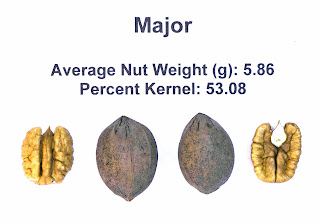Over 100 years ago, a seedling pecan tree growing near the confluence of the Green and Ohio Rivers (in Kentucky) was discovered that would become the foundation of this century's most important northern pecan cultivars. Introduced in 1908, 'Major' quickly became known as a disease resistant pecan cultivar that produces quality kernels every year. Today, 'Major' is one of the old standards of the northern pecan industry.
In the years to come, the importance of 'Major' to northern pecan growers may change. 'Major' may become better know as the disease resistant parent of two important cultivars--Kanza and Lakota. Kanza resulted from a controlled cross of Major and Shoshoni, while Lakota has Mahan and Major parentage. Looking at all 3 nuts, you might not suspect Major as being a parent of both Kanza and Lakota. However, Major has transferred excellent pecan scab resistance to both progeny.
The other day I spent some time to inspect the crops held by many of the cultivars we have under test. As usual, our large 'Major' trees (30 yrs-old) had a decent crop of nuts. Just like the old timers say, you can always rely on 'Major' to produce nuts.
I then went on to inspect the crops set by Major's daughters--Kanza and Lakota. After a tremendous crop last year, Kanza has set a fair crop this year (photo at right). Kanza had us fooled most of the year because we didn't see many nuts in the lower portion of the canopy. Once the leaves started to fall, we spotted a good crop of Kanza nuts up in the tree tops. (This is the first indication we might need to thin our Kanza block).
Lakota (photo at left) also set a good crop of nuts in 2011. In fact, Lakota may have produced too many nuts for this drought-stricken, growing season. However, Lakota is like its Major parent. If water becomes limiting, the nuts become smaller but they still produce a quality kernel.
Over the next 10 to 15 years we will learn if the daughters of Major (Kanza & Lakota) become the reliable standards in which northern pecan growers can count on.



